7 Types of Arborvitae for Massive Lawn Street Appeal
Author: Jen Worst | Editor: Omar Alonso
Review & Research: Jen Worst & Chris Miller
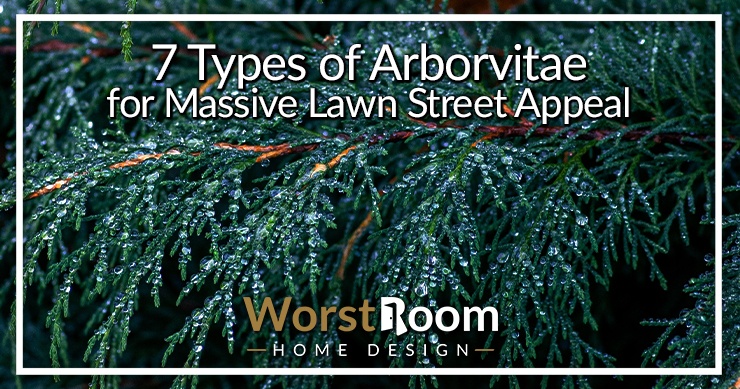
Anyone who's into gardening and has a lawn or enough area in their backyard is probably familiar with at least one of the different types of arborvitae.
You will most probably find it adorning houses in the suburbs or in big mansions. They are particularly preferred because of the low maintenance necessary to take care of them.
If you're looking to cultivate some arborvitae as types of hedges or bushes around your home, it's vital that you know about the different types of arborvitae. These plants are available in a wide variety and are subtly different from one another.
Our article will familiarize you with some of the most popular varieties of arborvitae and help you find an attractive one.
7 Types of Arborvitae
Below are descriptions of 5 of the most popular arborvitae varieties currently available in most gardening shops. Go through them to have an understanding of their structure and aesthetics to determine which one will make your garden stand out spontaneously the most.
Globe Arborvitae
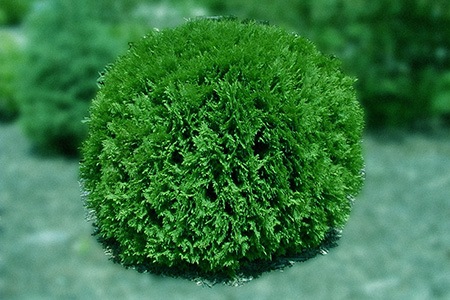
Among the many arborvitae varieties out there, nothing has a bolder exterior than the Globe Arborvitae. The main reason behind its eye-catching ability is its hulking structure that has a shape similar to a globe.
Its spherical body makes it puffier and takes up quite a bit of space than most other alternatives, making it difficult to ignore. Although the Globe Arborvitae is thick and looks chubby due to its circular figure, do not worry about maintenance.
Unlike most arborvitae tree types, you won't have to clip it with hedge clippers constantly constantly. It surprisingly holds up its shape and density as it continues to grow.
Therefore, it requires significantly less pruning, making it ideal as a lawn shrub. Interspersing it with types of boxwood shrubs can really look nice in the lawn of a business establishment.
In terms of durability, the Globe Arborvitae is extremely hardy and dependable. Even though it qualifies as a shrub, it's far sturdier than maximum plants under this class.
You won't have to worry about it during snow or rainfall as it has an amazing capacity to adapt to harsh weather conditions. Furthermore, it also works effectively as a protector of smaller plants from gusts.
Convenience is one of the key factors that you will get to experience when growing Globe Arborvitaes. They are perfectly suitable for growth in pots and tubs, making them more comfortable for moving around.
On top of that, these types of arborvitae can grow up to 5 feet in height when they hit full maturity, making them effortlessly stand out in gardens.
Emerald Green Arborvitae
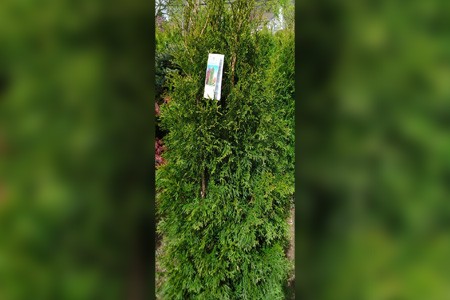
If you're living in the countryside and want to emulate the aesthetics of a forest around your farmhouse, then the Emerald Green Arborvitae is perfect for you.
These shrubs can grow up to gargantuan sizes of 30 feet on average, with a total width of 10 feet. You will feel the same vibes as living in a jungle when they hit full maturity.
A wonderful thing about having Emerald Green Arborvitae in your garden is the vibrancy it will add to your abode and its ability to enhance the overall aesthetics.
These variations sport a luscious green color when they are young, making your lawn feel warm and inviting. It becomes dark green once it matures, letting you use it as a living screen too.
Another amazing thing about the Emerald Green Arborvitae is the minimal maintenance it requires to retain its beauty. Its shape is similar to that of a pyramid, which lets it have a unique aesthetic from the start.
Therefore, you won't have to spruce up these arborvitae types for it to have an acceptable figure, and just let the green foliage grow naturally.
There's only one downside to growing the Emerald Green Arborvitae. It requires a very specific soil condition for it to have a healthy structure and receive proper nourishment. Learn about the fertilizer numbers and have your soil tested if you want to optimize it.
This type of plant only grows in swampy areas properly. Therefore, you're fresh out of luck if you're living in the plains or mountainous regions.
American Arborvitae
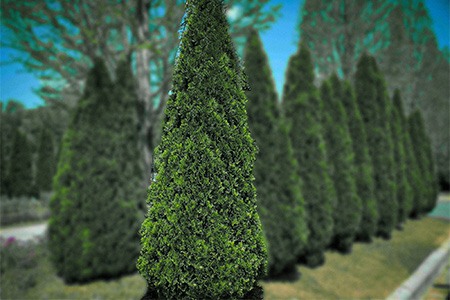
Probably the most popular form of arborvitae among gardeners in general, this variety gets its name from its place of origin; Minnesota, USA.
You will love growing the American Arborvitae as it particularly thrives in a moist environment. Its universal compatibility makes it perfect for growth in almost all conditions.
A unique factor about the American Arborvitae is its structure and aesthetics. This plant can grow up to staggering heights of 40 feet, making it one of the largest of its kind.
Moreover, the leaves have a dark green hue to them, and they grow all over the place. Therefore, it's perfect if you want to create a bush around your home.
Another excellent reason for growing American types of arborvitae is the unparalleled privacy it can provide to your home.
Its hulking size makes it perfect for covering up your home from the sight of nosy neighbors and gives you the privacy you want. Moreover, it has the ability to block winds and protect your house in case a wildfire breaks out.
Although there are lots of upsides to growing American Arborvitae, there is one problem in particular that you should know.
Even though this plant can tolerate harsh weather conditions, its aesthetics take a toll over time. A rough climate can cause its leaves to turn yellow over time and fade.
False Arborvitae
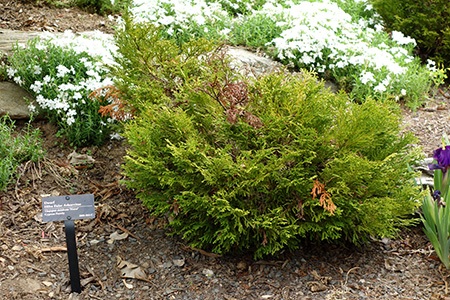
A common name for the Thujopsis, the false arborvitae, is found mostly in central Japan. The reason why a lot of people believe why it's fake is because of its dense, evergreen leaves.
However, it is as organic as its gets, and its consistent color quality makes it a dependable variation through which you can decorate your garden.
One of the most noteworthy things about the false arborvitae is its wood. Unlike most types of lumber out there, the one you will get from this plant is soft.
Therefore, you can use it effectively as firewood in the right types of fireplaces. Moreover, it has a yellowish-white hue on it, providing a wildly different color combination in comparison to most garden trees.
Another great factor about the false arborvitae is the unique design of its leaves. Each leaf has a unique shade of green that resembles emeralds. The leaves of all arborvitae are flat with shoots all lying in a single plane. They tend to measure between 0.04 inches to 0.4 inches (1 mm to 10 mm).
On top of that, it has an underside with a white and silver color combination. Therefore, it's a much more viable option if you want your garden to look different from the more conventional kind.
Even though there are lots of perks to growing the false types of arborvitae trees, there is a significant issue with it. Conventional versions of this plant grow up to heights of 115 feet.
Therefore, it's unsuitable for use in personal gardens and yards and difficult to manage. If you want to grow this variation, it will be wise to go for the dwarf rendition.
Techny Arborvitae
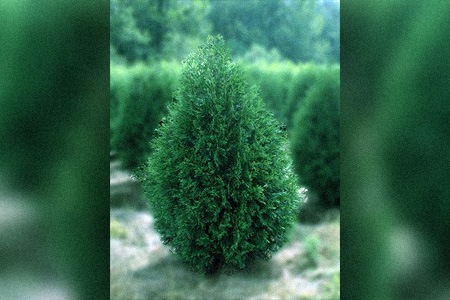
Techny Arborvitae is the best type to grow around your house because of its wide availability. You can find seeds of this plant in almost all gardening stores, and its growing process is relatively easy.
Furthermore, it grows in most soil and climate conditions. Therefore, it easily thrives in most areas without any hassle.
A great quality about the Techny Arborvitae is its growth period. It grows up relatively faster than most variations, making it perfect for those who are inexperienced with gardening.
Furthermore, it begins to transform into a pyramid shape as it continues to get bigger. Therefore, you won't have to go through the tiring process of giving it shape through sprucing.
Another special property of the Techny Arborvitae is its significant broadness. These arborvitae types grow extremely wide once it matures.
Therefore, it's perfect for sitting down underneath it on a warm summer evening and reading a book because of the massive shade it can provide. Furthermore, it's perfect for growing around the fences for privacy.
Lastly, the third and final quality that makes the Techny Arborvitae so worthwhile is its longevity. Most shrubs tend to get harmed thoroughly when it snows and from the dryness of the cold.
However, this variation can easily bear the harshness of winter. Therefore, you won't have to worry about providing it with high maintenance during this time.
Firechief Arborvitae
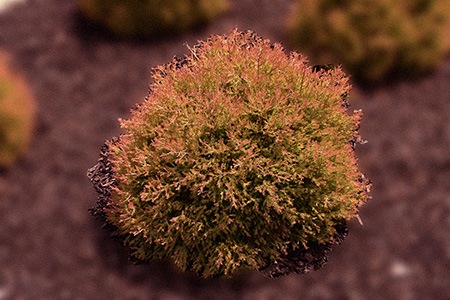
If you're looking for an option that tends to stay smaller with less intervention, then the compact Firechief Arborvitae may suit your needs. It's named that way due to the beautiful changes in color in goes through throughout the seasons.
The foilage of this intriguing shrub green in the winter, gold in the spring, orange in summer, and a red color in autumn. If you let this be the dominant shrub in your garden, you'll experience a new aesthetic every season.
Instead of being pyramidal types of arborvitae trees, it's a smaller globe shaped choice. It's pretty resistant to disease and pests, requires little pruning, and even resists windburn and sunburn. You can't beat that.
Make sure you're in the USDA zones from 5a to 8b if you want to grow this effectively. It grows slowly and needs to be in partial shade but can handle full sun as well. It will grow between 2 and 4 feet tall and 2 and 4 feet wide, largely maintaining a spherical shape.
North Pole Arborvitae
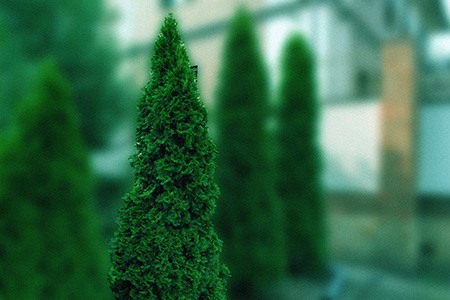
If you're in North America and you would like arborvitae types that aren't as tall as a Green Giant or as small as a Firechief, Golden Globe arborvitae, or a Dwarf Golden arborvitae, look no further than the North Pole tree.
These are tall and thin and can be grown in thin strips of yard such as between houses in tight neighborhoods. They stay green all year round, being true evergreens, and are resistant to winter burn.
They don't have problems from air pollution, insect infestations, or tree diseases, though they do require watering if you have a dry spell. They're pretty low maintenance and hardy, meaning you can trust them to be decorative.
Arborvitae Species
Of the actual Thuja genus that comprise all of the arborvitae varieties, there are 5 total. Those are:
- Thuja Karaiensis Nakai - Called Korean Thuja, where it largely grows as well as in Northeast China.
- Thuja plicata Donn ex D.Don - This is the famous Western Red Cedar that grows up and down the west coast of the United States and Canada. They're known for being able to become otherworldly-levels of gigantic.
- Thuja Occidentalis L. - Referred to as the Northern White Cedar and the Eastern Arborvitae, it grows in the eastern regions of the USA and Canada.
- Thuja Sutchuenensis - Hailing from Sichuan, Chongqing in China, it's knows as Sichuan Thuja sometimes. It's nearly extinct if not grown by human hands.
- Thuja Standishii - Called Japanese Thuja due to coming from areas in Japan such as Honshu and Shikoku.
It is among these varieties that all other arborvitae tree types come from. There are less well known and easy-to-grow and maintain types you can investigate such as:
- Lutea
- Holmstrup
- Wareana
- Woodward
- Little Giant
- Globosa
- Danica
- Brandon
- Whipcord
- Sunkist
But you should stick to the 7 mentioned varieties of arborvitae above for the best results.
Types of Arborvitae to Improve Your Lawn Hedges
All that's left is for you to decide which variation will go best with your garden's layout and head over to your nearest gardening store. In just a few months, you will have wonderful arborvitaes lining up your fence.
And there you have it, the most prominent but different types of arborvitae that you can consider for decorating your garden. Each of their unique properties is bound to brighten up your yard and make it an inviting place for you and your family to spend evenings.



